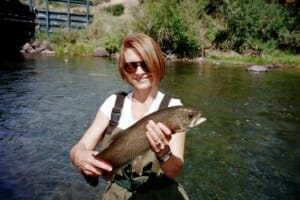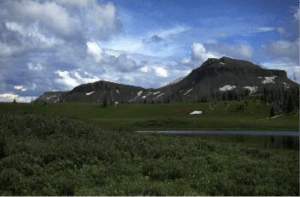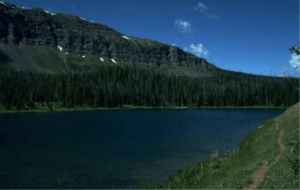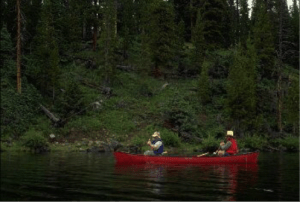Thinking of summer? Planning your trips? The Flat Tops offers a unique combination of streams and mountain lakes, with a variety of fishing opportunities.
Fly Fishing anywhere is fun. But there’s nothing quite like fly fishing in one of Colorado’s remote wilderness areas. From the small streams to high alpine lakes, the fish are unpressured and the scenery is unbeatable. Opportunities exist for trophy sized fish due to the remoteness of many fishing areas.
Fly fishing Colorado’s wilderness lakes and streams is an experience you’ll never forget. These waters may be hard to get to, but they are impossible to forget. The Flat Tops is an angler’s paradise, featuring more than 100 lakes and several hundred miles of trout streams that aren’t accessible by any motor vehicle. Whether catching cutthroat and brook trout by the dozen in a meandering meadow stream, or landing bruisers in a blue alpine lake at timberline, there are opportunities for everyone.
However, for someone who has never ventured into the backcountry in search of trout, it can be hard to know where to begin. When it comes to remote backcountry fly fishing in Colorado, there are a multitude of options. One of the great things about our wilderness areas is a diversity of fishing options. The Flat Tops is a prime example. Angler’s here can choose to focus on small stream fishing, alpine lakes or beaver ponds. Each requires different techniques, advantages, challenges and opportunities.
The Flat Tops Plateau in northwestern Colorado was created by basalt and andesite flows only millions of years ago (young by Colorado standards). This area is home to numerous lakes and streams. A large part of the Flat Tops, 267 square miles, is designated as wilderness. Trappers Lake is a wild trout water, holding the largest concentration of Colorado River cutthroats in the world. The Colorado Division of Wildlife collects spawn here in June and the fingerlings produced are used to stock other Colorado waters.
Types of Water and Knowing Where to Start
The Flat Tops Wilderness Area has countless small streams for trying your luck on cutthroats and brookies.
No matter what type of water you’re looking for, it might be a good idea to speak with Forest Service personnel or other local experts that know a particular area. While some alpine lakes and streams look promising, some will provide better opportunities than others. We also recommend looking at topographic maps and using Google Earth to locate bodies of water. This is especially true for beaver bonds, which can change from year to year. Google Earth can provide a more updated view than what might appear on a map.
There are a wide variety of waters to be found in Colorado’s wilderness areas, and each one requires a unique approach. While there will be some overlap between them, let’s break them down separately to help keep it simple.
Creeks and rivers in the upper reaches of theRocky Mountains tend to be compact bodies of water. Near their headwaters, most of these streams run cold and clear, providing excellent habitat for native cutthroat trout. These waters are also ideal habitat for wild reproducing brook trout and occasionally, rainbow and brown trout as well. Except for a few weeks during runoff toward the middle of June, the crystal clear water makes approach and presentation of flies a delicate matter. Because of their opportunistic diet and lack of fishing pressure, these trout are seldom picky eaters. However, they are easily spooked by movement along the bank or a careless cast into a calm pool.
We always recommend starting a prime stretch of water from the downstream end and working your way up, approaching the fish from behind. Even when approaching from downstream, it’s important to keep a low profile and sometimes, remain several feet back from the bank.
When you’ve found a good spot below a pool or run, cast your fly upstream, using a long leader to avoid laying your fly line right over the trout’s head. We recommend using 9-foot fluorocarbon leaders in 6x or 7x. As your fly drifts back toward you, carefully strip in the slack so that you’re ready for a strike, but without altering the natural drift of the fly.
This upstream-cast approach is ideal for dry fly fishing and dry-dropper rigs. However, when nymphing is necessary, a high-stick approach is often best. Situating yourself directly across from the run you intend to fish, simply cast your fly about 45 degrees upstream. Immediately mend, carefully laying your leader upstream of your fly. Then, with your rod tip held high, keep your fly line off the water and let your rod tip follow your strike indicator, allowing a perfect dead drift down through the hole.
Alpine lakes present a whole new set of challenges. Here, fish aren’t facing any one direction. And instead of holding in runs or riffles, they’ll be cruising along shorelines or structures in search of food. But like streams, the crystal clear water will make stealthy presentation a priority.
There are two primary techniques that we use on lakes – still-fishing dry flies, usually with a dropper dangling below it, or stripping streamers and nymphs.
When still-fishing dries, patience is key. Instead of trying to chase rises across the surface of the water, we recommend casting your fly to an area where trout have been rising and leaving it there until another cruising trout passes by. If you try to cast toward each new rise, the disturbance on the water can easily spook fish. If you fly is in a good position, just hang in there and wait. It’s only a matter of time before a trout comes along.
When fishing dries, it often pays to have a dropper beneath the surface. This gives trout a second menu option. Patterns that represent a drowned or suspended caddis pupa, mayfly larvae, or worm can be great options to offer beneath your dry.
When no dry fly action is apparent, stripping streamers and larger nymphs can be a great tactic on lakes for big cutthroat and brook trout. The key is casting over underwater structure or in areas where fish are cruising for food. Steep drop-offs, brush piles and weed beds are all likely spots. When stripping your fly, experiment with different speeds and depths until you find hungry fish. On hot sunny days, it may require a sinking line and a good deal of weight to reach the fish. Other times, they may be cruising the shallows, right along the bank.
The calm, glassy waters of beaver ponds can be some of the most challenging and most rewarding places to fish in a wilderness area. Prolific insect life can make for incredible trout habitat, and the cutthroat trout in some of our beaver ponds in the Flat Tops Wilderness become quite large.
Like alpine lakes, using streamers can be a useful tactic on beaver ponds. However, the best time to fish a beaver pond is during a good dry fly hatch. A delicate presentation is the top priority, so gently dropping a caddis or mayfly pattern onto the surface is often your best bet. We recommend using very fine, 12-foot leaders and lightly weighted flies that will land on the water with minimal disturbance.
When approaching the water, be sure to keep a low profile. It might even be necessary to cast from your knees or use small willows for concealment. But any trouble required to get into position will be rewarded when a trout crashes through the surface after your fly. There are few things more exciting than catching an evening caddis hatch on a beaver pond full of hungry trout.
What is the best time to go?
Planning a loop that passes a variety of waters will make for a memorable adventure. Most wilderness areas in Colorado are accessible by the end of June. Immediately after ice-off can be a great time to land large fish as they scour shorelines for drowned insects and worms from the runoff. By the second week in July, dry fly fishing will have turned on in the high country, and will remain active through early September, or the first hard freeze.
One of the advantages of early season wilderness fishing is even less pressure than normal. Trails receive their heaviest use between the 4th of July and Labor Day. Exploring these waters in June gives you the first crack at hungry trout. The downsides however, are higher water levels from runoff and the potential for a muddy experience.
As temperatures rise and runoff levels subside in early to mid-July, insect activity will begin to peak. Although wilderness traffic is highest during mid-summer, even a busy day inside a wilderness boundary will look uninhabited compared to an urban state park or a popular campground. And the period from mid-July until at least Labor Day is arguably the best fishing of the year.
Fall in Colorado can be an excellent time to fish, but the weather can be unpredictable and access more difficult. Depending on early snowfall and temperatures, the fishing will often remain steady well into October. However, by that time most campgrounds are closed and unmaintained Forest Service roads become impassable with snow. If you plan a fall fishing trip, bring a good set of tire chains and be prepared for any weather. A dry road on the way to the trailhead could be a mess before you leave.
CONTACT US

If you have questions or would like to check availability, call 970.926.0216 or complete the form below.





